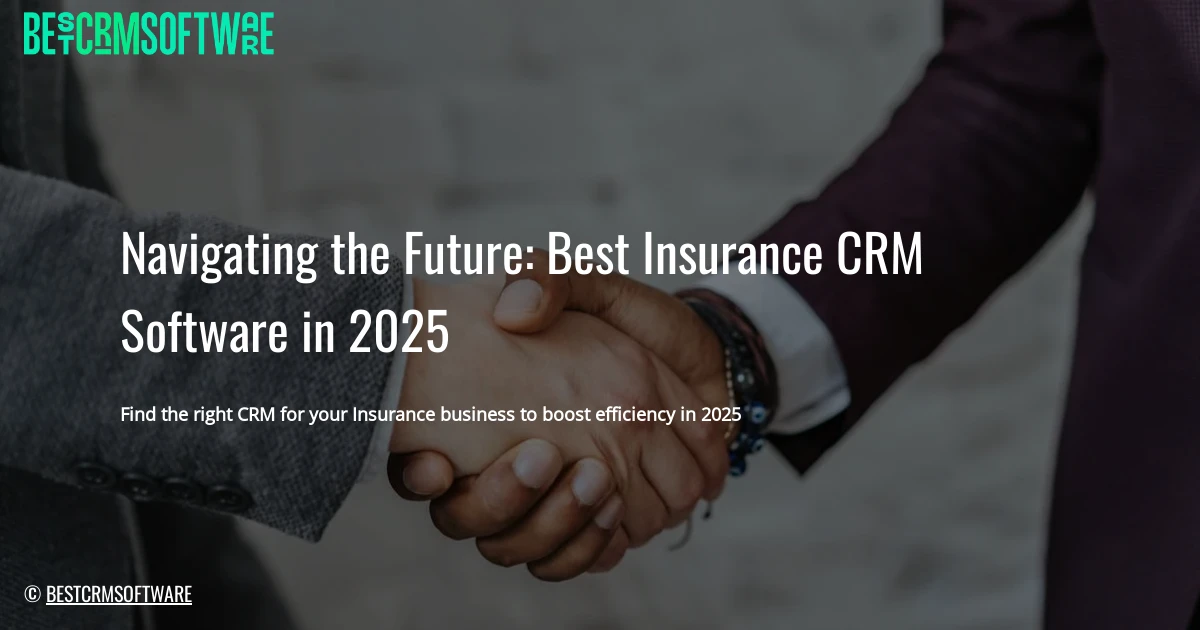Find the right CRM for your Insurance business to boost efficiency in 2025
Introduction: The Insurance Industry in 2025
The insurance industry is on the cusp of a transformative evolution, driven by evolving customer expectations and rapid technological advancements. Understanding this evolving landscape is crucial for insurers to navigate the future effectively.
Defining Customer Relationship Management (CRM) in Insurance:
At its core, Customer Relationship Management (CRM) is the systematic approach to managing interactions with current and potential customers. In the insurance context, this means building relationships with policyholders and prospects, understanding their needs, and providing tailored services. This involves capturing valuable data about clients, their policies, interactions, and preferences to create a personalized and efficient customer journey.
The Evolving Landscape of Customer Expectations and Technology:
Today’s insurance consumers are digitally savvy, demanding instant gratification, personalized experiences, and seamless digital interactions. They expect transparency, accessibility, and proactive communication, driven by the rapid adoption of artificial intelligence (AI), machine learning (ML), and mobile technology.
The Need for Specialized CRM Solutions:
To thrive in this dynamic environment, insurance providers need to adapt. Generic CRM solutions are not enough. Specialized CRM solutions tailored for the insurance industry will be paramount in 2025 and beyond. These solutions will need to seamlessly integrate with existing systems, offer features specific to insurance workflows (like claims management, underwriting, and policy administration), and provide insightful analytics for risk assessment and targeted marketing.
This means leveraging cutting-edge technologies such as AI-powered chatbots for 24/7 support, personalized risk assessments based on real-time data analysis, and seamless integration with wearable technology to facilitate data collection and customized policy offerings.
In essence, navigating the future of insurance will require embracing a customer-centric approach, leveraging technological innovation, and embracing the power of specialized CRM solutions to ensure a competitive advantage in 2025 and beyond.
The Power of CRM in Insurance
The insurance industry is undergoing a significant transformation, driven by digitalization and evolving customer expectations. In this rapidly changing landscape, the ability to cultivate strong customer relationships becomes paramount. This is where Customer Relationship Management (CRM) software enters the picture, offering a powerful suite of tools designed to streamline operations and optimize customer interactions.
Here’s why CRM systems are becoming indispensable in the insurance sector:
1. Enhanced Customer Engagement:
- Personalized Experiences: CRM systems collect and analyze data about individual policyholders, allowing insurers to tailor communications and offers to specific needs. This personalized approach fosters trust and loyalty, increasing customer satisfaction.
- Proactive Service: CRM facilitates proactive communication. Insurers can send reminders about policy renewals, offer relevant add-on services, and reach out to customers with information that enhances their understanding of their policies.
- Seamless Omnichannel Engagement: Customers today interact with brands across multiple channels, be it email, phone, chat, or social media. CRM enables insurers to manage all these interactions from a single platform, offering a cohesive and consistent customer experience.
2. Streamlined Workflows:
- Centralized Data: CRM centralizes all customer information in one place, eliminating silos and promoting information sharing between departments. This helps agents provide comprehensive and efficient service.
- Automated Tasks: Routine tasks like data entry, appointment scheduling, and follow-up communication can be automated, freeing up valuable time for agents to focus on high-value interactions with customers.
- Improved Collaboration: CRM systems facilitate seamless collaboration between sales, service, and underwriting teams, improving efficiency and accuracy throughout the entire customer journey.
3. Data-Driven Insights:
- Customer Analytics: CRM provides valuable insights into customer behavior and preferences. This data helps insurers understand what drives purchasing decisions, identify potential risks, and tailor marketing campaigns more effectively.
- Predictive Analytics: By analyzing historical data, CRM systems can predict customer churn, identify potential fraud cases, and estimate risk profiles, allowing insurers to make proactive decisions.
- Enhanced Decision-Making: Data-driven insights equip insurers with the knowledge needed to make strategic decisions related to pricing, product development, and customer segmentation.
The power of CRM lies in its ability to bridge the gap between insurers and their customers, building stronger relationships, improving efficiency, and ultimately driving growth. As the insurance industry continues to evolve, CRM will become an even more critical tool for success.

© fauxels
Essential Features of Leading Insurance CRMs
As the insurance industry embraces digital transformation, choosing the right CRM software is paramount. To navigate the future effectively, insurance companies need CRMs equipped with features that enhance customer experience, streamline operations, and provide valuable insights. Here are some key features to prioritize when evaluating insurance CRM software in 2025:
1. Policy Management:
- Comprehensive Policy Database: A robust policy management system should offer a centralized database for storing and accessing all policy details, including coverage, terms, and renewal dates.
- Automated Renewals and Reminders: Streamlining the renewal process with automated reminders and renewal processing can improve customer retention and reduce administrative burden.
- Policy Management Integrations: Integration with other systems, such as billing and underwriting platforms, ensures data consistency and simplifies the entire policy lifecycle.
2. Claims Processing:
- Digital Claims Filing: Enable customers to file claims easily through a user-friendly online portal.
- Automated Claim Triage and Routing: Efficiently categorize and assign claims to the appropriate teams based on complexity and urgency.
- Real-Time Claim Status Updates: Provide customers with timely updates on their claim status through notifications or personalized dashboards.
3. Agent Portals:
- Centralized Access to Client Information: Agents should have secure access to all customer data, including policy details, claims history, and communication records.
- Automated Task Management: Agent portals can support task management, allowing agents to prioritize activities and track their progress.
- Lead Generation and Sales Tools: Provide agents with the tools they need to nurture leads, track their performance, and increase sales.
4. Customer Self-Service:
- Online Policy and Claim Access: Offer customers 24/7 access to policy information, claim status, and other relevant documents through a secure portal.
- Knowledge Base and FAQs: Provide easily accessible self-service resources, like a comprehensive knowledge base and FAQ section.
- Live Chat and Chatbot Support: Implement live chat or chatbots to provide immediate support and answer basic inquiries.
5. Marketing Automation:
- Personalized Communication: Segment customer lists based on demographics, purchasing behavior, and engagement to send personalized marketing campaigns and targeted communications.
- Automated Campaign Scheduling: Optimize marketing campaigns by setting up automated schedules for emails, SMS messages, and other communication channels.
- Campaign Analytics: Gain valuable insights into campaign effectiveness by analyzing metrics like open rates, click-through rates, and conversion rates.
6. Analytics and Reporting:
- Dashboard Customization: Enable users to customize dashboards to visualize key performance indicators (KPIs) and identify trends.
- Data Visualization Tools: Offer comprehensive reporting tools for data analysis and presentation of key metrics and insights.
- Actionable Business Intelligence: Translate data into actionable insights that drive operational improvements, product development, and sales strategies.
7. Integrations with Other Business Systems:
- API Connectivity: Ensure the CRM software seamlessly integrates with other vital business systems, including billing, underwriting, claims management, and policy administration platforms.
- Data Exchange: Securely exchange data across integrated systems to ensure accuracy and reduce manual data entry.
By incorporating these features, insurance companies can empower their teams to provide personalized customer experiences, optimize processes, and make informed business decisions. This approach not only streamlines operations but also fosters loyalty and helps insurance companies stay ahead of the curve in a rapidly evolving market.
Top Insurance CRM Contenders for 2025
The insurance landscape is evolving rapidly, fueled by digital transformation and heightened customer expectations. As we venture into 2025, insurance providers must leverage cutting-edge technology to stay ahead. A robust and efficient CRM system is paramount to success. Let’s delve into the key contenders expected to dominate the market:
1. Salesforce Financial Services Cloud:
- Strengths: Salesforce’s reputation for innovation and industry-specific features make it a leading choice. Its Financial Services Cloud offers deep insights into customer financial data, allowing for personalized recommendations and risk assessments.
- Weaknesses: High cost, implementation complexity, and potential dependency on Salesforce consultants are significant considerations.
- USPs: Advanced analytics, AI-powered insights, seamless integration with Salesforce ecosystem, robust security and compliance features.
- Target Audience: Larger insurance companies with complex needs, aiming for digital transformation and enhanced customer engagement.
2. Microsoft Dynamics 365 for Insurance:
- Strengths: This platform provides a holistic view of customer interactions, integrates seamlessly with other Microsoft solutions, and offers customizable workflows.
- Weaknesses: Can be less flexible than Salesforce and might not offer the same depth of industry-specific functionality.
- USPs: Powerful automation tools, seamless integration with other Microsoft tools, strong data security features, robust reporting capabilities.
- Target Audience: Mid-sized to large insurance companies seeking a powerful platform with integration across various business functions.
3. Zoho CRM:
- Strengths: Zoho CRM offers a robust, affordable, and user-friendly platform, ideal for mid-market insurance companies. It boasts various features and caters to various business needs.
- Weaknesses: Might lack the advanced analytics and customization capabilities offered by premium platforms like Salesforce.
- USPs: Comprehensive functionality at an attractive price point, intuitive interface, ease of implementation, wide range of integrations.
- Target Audience: Smaller to mid-sized insurance companies seeking a comprehensive yet affordable CRM solution with excellent usability.
4. Oracle Siebel:
- Strengths: A veteran in the CRM market, Oracle Siebel offers robust functionality, excellent integration capabilities, and a proven track record in the insurance industry.
- Weaknesses: Can be complex to implement and may not be as user-friendly as some modern platforms.
- USPs: Long-standing expertise in the insurance sector, highly customizable solutions, strong integration with other Oracle products, reliable data security.
- Target Audience: Large insurance companies looking for a mature and secure CRM platform with a deep understanding of the industry.
5. SAP CRM:
- Strengths: SAP’s strengths lie in its industry-specific solutions, comprehensive integrations, and advanced data analytics capabilities.
- Weaknesses: Its implementation can be complex, and the learning curve for users can be steep.
- USPs: Integration with SAP’s ecosystem, powerful analytical capabilities, strong support for regulatory compliance, focus on business process optimization.
- Target Audience: Larger insurance companies looking for a fully integrated and powerful CRM platform, particularly with a strong focus on back-end operations.
These are just some of the leading CRM platforms expected to be crucial players in the insurance industry in 2025. When choosing the right solution, it is critical to carefully assess factors like budget, company size, business needs, desired functionalities, and integration with existing systems. A comprehensive evaluation will ensure the chosen CRM empowers insurers to navigate the future successfully, driving growth, improving customer satisfaction, and staying ahead in an increasingly competitive landscape.

© fauxels
Choosing the Right CRM: A Tailored Approach
Finding the perfect insurance CRM isn’t a one-size-fits-all endeavor. To ensure a seamless integration and maximize your ROI, a tailored approach is key. This section will guide you through choosing the best-fit CRM solution by considering the unique characteristics of your insurance business.
1. Sizing Up Your Needs:
- Small Businesses: Lean, user-friendly, and cost-effective solutions are paramount for small insurance agencies. Focus on CRMs with intuitive interfaces, strong customer service features, and integrations with existing systems.
- Medium Businesses: Seek a balance between affordability and robust functionality. Consider CRMs with advanced reporting and analytics capabilities, customizable workflows, and integration with core business systems like policy management and billing.
- Large Enterprises: Complex insurance enterprises require robust solutions with high-volume data processing capabilities, scalability for growth, and a dedicated support team. Advanced CRM functionalities like automated lead routing, advanced analytics, and omnichannel customer interactions become essential.
2. Navigating Insurance Lines:
- Life and Health Insurance: CRMs must cater to the specific needs of this segment, which often involves complex client interactions and long sales cycles. Look for features like policy management integration, risk profiling, and strong lead nurturing tools.
- Property and Casualty Insurance (P&C): P&C insurance demands efficient handling of claims and policy renewals. Select a CRM with strong case management capabilities, automated policy renewal features, and integrations with existing claims systems.
- Specialty Lines: CRMs tailored for specialty insurance lines (e.g., marine insurance) require customization capabilities and niche industry expertise. Focus on providers offering industry-specific features, data management tools, and integrations with specialized software.
3. Balancing Budget and Features:
- Budget Considerations: While features and functionalities are crucial, it’s vital to establish a realistic budget. Many CRM providers offer flexible subscription plans, ranging from basic packages for smaller businesses to comprehensive suites for enterprises.
- Feature Prioritization: Identify the most critical features based on your specific needs. Determine your priorities, whether it be lead management, sales automation, customer service, or data analytics. Opt for solutions that prioritize these areas without unnecessary fluff.
By carefully considering your business size, insurance line, budget, and desired features, you’ll be equipped to identify the perfect CRM that empowers your agency’s growth and success in 2025 and beyond.
CRM Success Stories in Insurance
The insurance industry is embracing the power of CRM software to drive transformative results. Leading insurers have successfully leveraged these systems to not only improve customer relationships but also achieve tangible financial benefits. Here are some real-world examples demonstrating the transformative impact of CRM implementation:
1. Allstate:
Allstate implemented a comprehensive CRM solution to personalize their customer interactions and streamline their sales process. By leveraging customer data and analytics, Allstate has been able to:
- Boost customer satisfaction: Personalized communication and targeted offers resulted in a significant increase in customer loyalty and satisfaction.
- Increase sales conversions: The system helps identify sales opportunities and facilitates a more efficient sales cycle, leading to a substantial rise in revenue.
- Reduce operating costs: Streamlined processes and improved communication have optimized resource allocation and reduced administrative burdens.
2. Farmers Insurance:
Farmers Insurance recognized the need to modernize their customer experience and implemented a cloud-based CRM solution. This enabled them to:
- Improve customer retention: Personalized communication strategies fostered stronger customer relationships, leading to higher retention rates.
- Increase cross-selling and upselling: The CRM system facilitated targeted marketing campaigns and tailored product recommendations, boosting sales of additional insurance products.
- Enhance agent productivity: Simplified workflows and access to comprehensive customer information enabled agents to efficiently serve their clients.
3. AIG:
AIG leveraged a sophisticated CRM system to optimize their claims processing operations. By automating tasks and integrating with existing systems, they were able to:
- Expedite claim settlements: Faster claim processing times led to increased customer satisfaction and improved reputation.
- Reduce claim-related costs: Streamlined processes and efficient data management helped minimize errors and save costs associated with claims.
- Improve fraud detection: Enhanced data analysis capabilities enabled proactive identification and prevention of fraudulent claims.
These case studies highlight how insurance companies are successfully utilizing CRM systems to drive operational excellence and customer-centric strategies. By harnessing the power of data and leveraging integrated functionalities, insurers can unlock numerous benefits, leading to higher customer satisfaction, increased sales, optimized costs, and enhanced efficiency. This trend will only accelerate in the years to come as the insurance industry continues to adopt and refine CRM solutions for the ever-evolving landscape of customer needs and expectations.

© fauxels
The Future of Insurance CRM: Trends to Watch
The insurance industry is on the cusp of a transformative era, driven by rapid technological advancements. As we look towards 2025, insurance CRM solutions will evolve dramatically, adapting to new trends and empowering agents and customers alike.
Emerging trends to shape the future of CRM in the insurance industry:
1. Artificial Intelligence (AI) and Machine Learning (ML) for Predictive Analytics, Personalized Experiences, and Automated Tasks:
AI and ML are revolutionizing the insurance industry. These technologies will play a crucial role in future CRM systems, driving:
- Predictive analytics: AI models will analyze vast datasets, identifying risk factors and predicting customer behavior to personalize offers, tailor insurance policies, and enhance fraud detection.
- Personalized customer experiences: AI-powered chatbots and virtual assistants will deliver tailored, round-the-clock customer support, answer inquiries instantly, and offer proactive recommendations based on individual needs.
- Automated tasks: AI will automate repetitive tasks, freeing up agents to focus on high-value activities, such as building relationships and providing complex advice.
2. The Growing Importance of Mobile-First CRM Solutions for On-the-Go Agents and Customers:
In today’s digital world, accessibility is key. Mobile-first CRM solutions will be critical, providing agents and customers with instant access to insurance information, policy details, claims management tools, and communication channels directly on their smartphones or tablets. This shift will enhance efficiency, streamline interactions, and boost customer satisfaction.
3. Integration of Internet of Things (IoT) Devices with CRM Systems to Enable Proactive Risk Management and Personalized Insurance Offerings:
The interconnectedness of IoT devices is poised to revolutionize risk management and insurance offerings. Integrating IoT data into CRM systems will enable:
- Proactive risk management: Real-time monitoring of wearables, smart home devices, and vehicle sensors will detect potential risks, allowing insurers to intervene proactively and offer preventive measures.
- Personalized insurance: By analyzing data from connected devices, insurers can develop highly personalized insurance packages based on individual behaviors, driving tailored premiums and creating a more customer-centric experience.
4. The Rising Focus on Data Privacy and Security in the Context of CRM:
As the use of customer data intensifies, data privacy and security will become paramount. Insurance CRM solutions in 2025 will need to:
- Implement robust security protocols: Data encryption, access controls, and multi-factor authentication will be crucial to safeguard sensitive customer information.
- Comply with evolving regulations: Systems will need to adapt to data privacy laws such as GDPR and CCPA, ensuring compliance and ethical data handling.
- Empower customers: Individuals should have greater control over their data, with options to access, modify, and delete personal information as they wish.
In conclusion, the future of insurance CRM promises exciting possibilities. By leveraging emerging technologies, embracing new approaches to customer engagement, and prioritizing data security, insurance companies can create innovative solutions that meet the evolving needs of a digital world. The CRM of 2025 will not only enhance customer service and efficiency, but will also empower insurers to play a more proactive and personalized role in the lives of their clients.
Implementing Insurance CRM: Addressing Challenges and Ensuring Success
Adopting and implementing a robust Customer Relationship Management (CRM) solution is essential for insurance organizations seeking to thrive in the rapidly evolving landscape of 2025. While the potential benefits are vast – enhanced customer engagement, improved sales efficiency, and data-driven decision making – the path to successful implementation can be fraught with challenges. Here’s a look at some of the common hurdles insurance companies may encounter:
1. Resistance to Change: One of the biggest barriers is inherent human resistance to change. Shifting from legacy systems and established processes to a new CRM can be perceived as disruptive and demanding, leading to apprehension from employees who may feel overwhelmed or threatened by the transition.
2. Data Migration Hurdles: Successfully migrating existing customer data, policy information, and historical interactions to the new CRM system can be a complex and time-consuming endeavor. Ensuring data accuracy, consistency, and integrity during this transfer is critical to prevent errors and maintain data quality.
3. Integration Complexities: Integrating the new CRM with existing core systems (policy administration, claims processing, billing) and external data sources is another major challenge. The process demands technical expertise, robust integration protocols, and potential data mapping challenges.
4. User Adoption Rates: Achieving high user adoption rates is crucial for reaping the full benefits of the CRM system. If employees don’t use the system consistently, its value is significantly diminished. This challenge requires effective training, user-friendly interface design, and ongoing support to encourage adoption.
5. Ongoing Training Requirements: Training employees to effectively utilize the CRM’s functionalities and leverage its features requires a structured approach with regular refresher sessions. The success of training depends on the comprehensiveness of the curriculum, the availability of practical application scenarios, and continued support resources.
To overcome these hurdles and ensure the successful implementation of a CRM solution, insurance companies must:
- Address Resistance Through Communication and Engagement: Clearly communicate the benefits of CRM to employees, provide adequate training, and offer opportunities for feedback and ongoing support.
- Embrace Agile Data Migration Strategies: Develop a phased approach to data migration, prioritize data accuracy and integrity, and invest in appropriate tools and expertise for data cleansing and harmonization.
- Prioritize Seamless Integrations: Choose a CRM system with robust integration capabilities, work closely with IT teams to ensure seamless connections, and establish a clear communication protocol to address technical challenges.
- Promote User Adoption: Provide user-friendly interfaces, offer comprehensive training programs, and cultivate a culture of continuous learning and exploration of CRM features.
- Focus on Continuous Learning and Improvement: Invest in regular training programs and readily accessible support resources for users. Encourage employees to proactively seek ways to optimize CRM usage for improved performance and customer interactions.
Navigating the complex landscape of CRM implementation requires a strategic approach, proactive planning, and a commitment to continuous learning. By addressing the challenges and investing in a robust strategy for adoption, insurance companies can effectively harness the transformative power of CRM to enhance their business operations, drive customer loyalty, and achieve their strategic goals.

© fauxels
Data Security and Compliance in Insurance CRM
The insurance industry deals with incredibly sensitive data – personal information, financial records, health history, and more. This sensitivity elevates the importance of data security and regulatory compliance to paramount levels. As we look towards 2025, choosing an insurance CRM solution that prioritizes these elements is not just a good idea; it’s a necessity.
Why is Data Security Paramount?
Data breaches in the insurance industry can have devastating consequences. Stolen information can lead to identity theft, financial loss, reputational damage, and even legal repercussions. With rising cybercrime threats, it’s more important than ever to have robust security measures in place.
Meeting Regulatory Compliance Requirements:
Beyond protecting data from breaches, insurance companies must comply with a wide range of regulations, including:
- GDPR (General Data Protection Regulation): Applies to any company processing personal data of individuals in the European Union.
- HIPAA (Health Insurance Portability and Accountability Act): Protects sensitive patient health information in the US healthcare system.
- CCPA (California Consumer Privacy Act): Grants California residents specific privacy rights regarding their personal information.
- PCI DSS (Payment Card Industry Data Security Standard): Regulates the handling of credit card data.
How CRM Solutions Address Compliance:
Leading CRM providers understand the stringent demands of the insurance industry. They build their solutions with the following features:
- Data Encryption: All data, both at rest and in transit, is encrypted, minimizing the risk of unauthorized access.
- Access Control: Permissions can be set for different user roles, limiting access to specific data based on individual needs.
- Data Auditing and Logging: Detailed records of all user actions, including data access, modifications, and deletions, are maintained for transparency and accountability.
- Regulatory Compliance Tools: CRMs may include specific modules or integrations designed to streamline compliance with GDPR, HIPAA, or other regulations. This includes features like consent management tools, data erasure functionalities, and data subject access requests.
The Bottom Line:
Investing in a CRM solution designed for the unique needs of the insurance industry, with robust data security features and compliance functionalities, is not just about enhancing customer service; it’s a fundamental aspect of ethical business practices and responsible data management.
CRM on the Go: The Power of Mobile Accessibility
The insurance industry is constantly evolving, and with that, the need for adaptable and accessible solutions becomes paramount. This is where mobile-friendly CRM solutions step into the spotlight, revolutionizing the way insurance agents, brokers, and customers interact with each other and manage their policies.
Benefits for All:
- Agents and Brokers: Mobile CRM allows agents to access vital customer information, policy details, and client communication history in real-time, regardless of location. This means they can:
- Respond quickly to client inquiries: Immediate access to customer data allows agents to resolve issues and answer questions promptly, leading to increased client satisfaction.
- Develop personalized strategies: Agent’s mobile access empowers them to analyze client behavior and adapt sales and service strategies based on individual needs.
- Close deals on the go: Real-time information about quotes and policy options can be shared instantly, enabling agents to seal deals during meetings or client visits.
- Customers: Mobile CRM empowers customers to take control of their insurance needs and have a more seamless experience:
- Manage policies with ease: Access policies, claim history, payment details, and other relevant documents conveniently from a mobile device.
- Submit claims on the go: Streamline the claims process with mobile claim submissions, reducing time and effort for both customers and insurers.
- Stay connected 24/7: Communicate with agents, access support, and receive important notifications through intuitive mobile applications.
Use Cases of Mobile CRM:
- Real-time Policy Access: Imagine a customer needing to check their policy details while traveling. Mobile access allows them to do so with ease, instantly resolving any queries.
- Claim Submissions: An individual involved in an accident can easily file a claim on their phone, complete with images and details, instead of navigating complex paper processes.
- Communication Tools: Built-in messaging and chat functionalities within the mobile app foster a personalized and timely communication channel between clients and agents.
- Location-Based Services: Imagine a scenario where an agent is visiting a customer and can instantly access nearby locations or previous visits, improving service quality and responsiveness.
The Bottom Line: Mobile CRM is more than just a convenient tool. It’s a crucial component of modern insurance strategy. By empowering agents, brokers, and customers alike with 24/7 access to essential information and services, it fosters a stronger relationship and a smoother insurance journey for all.

© fauxels
Seamless Integration: Connecting Your Insurance Ecosystem
In the future of insurance, a standalone CRM is not enough. To truly thrive, it needs to seamlessly weave itself into your existing tech landscape, creating a connected ecosystem of powerful tools. Here’s how to best integrate your Insurance CRM with key software systems:
1. Policy Administration Systems (PAS):
- Real-Time Data Synchronization: Avoid duplicate data entry by ensuring real-time data flow between your CRM and PAS. Changes in policy details, renewal dates, and client information should automatically update in both systems.
- Policy Automation: Streamline workflows by triggering automated actions within your CRM based on policy events, such as renewals or claims. For example, automatically send renewal reminders, track lapse rates, or trigger personalized outreach campaigns based on policy type and value.
- Policy Analysis: Leverage CRM’s analytical capabilities to gain insights into policy data. Analyze customer demographics, policy trends, and renewal rates to optimize your sales strategies and identify potential issues.
2. Claims Management Platforms (CMP):
- Claims Reporting & Tracking: Integrate your CRM with your CMP to track claims statuses in real time. Allow agents to easily access and update claim details within the CRM, providing seamless communication with clients.
- Claim Resolution Automation: Automate routine tasks associated with claims management, such as assigning claims, sending status updates, and triggering follow-up actions, leading to faster resolution times.
- Customer Journey Mapping: By analyzing claim data alongside customer interaction history, you can create more tailored communication strategies and improve customer satisfaction during the claims process.
3. Accounting Software:
- Financial Integration: Establish direct data connections between your CRM and accounting software. This automates tasks like creating invoices, recording payments, and generating reports on customer revenue and expenses, offering a comprehensive view of your financial health.
- Revenue Attribution: Link sales activities within your CRM to specific revenue streams in your accounting software. This provides valuable insights into the effectiveness of sales efforts and allows you to optimize marketing campaigns and pricing strategies.
- Financial Compliance: Automate reporting requirements and comply with regulations by leveraging combined data from both systems.
4. Marketing Automation Tools:
- Customer Segmentation: Integrate CRM data to create detailed customer segments within your marketing automation platform. This enables highly targeted campaigns that resonate with individual needs and preferences.
- Automated Marketing Journeys: Trigger automated marketing campaigns based on customer interactions, such as a welcome message for new customers, renewal reminders, or post-sale follow-up emails.
- Personalized Communications: Use CRM data to personalize email campaigns, website content, and other marketing materials, delivering a tailored experience for each customer.
By achieving seamless integration, you empower your insurance organization to break down silos, streamline workflows, enhance customer engagement, and ultimately, drive business growth. In a future dominated by data-driven decisions and personalized experiences, this connected ecosystem will be crucial for navigating the dynamic insurance landscape.
Personalizing the Customer Journey with Insurance CRM
In today’s digitally-driven world, consumers expect personalized experiences, and the insurance industry is no exception. Personalization has become crucial for fostering trust and building long-lasting relationships with customers.
This is where Insurance CRM (Customer Relationship Management) software emerges as a powerful tool. CRMs empower agents to understand individual customer needs and preferences, allowing them to deliver tailored policy recommendations, proactive support, and ultimately enhance overall customer engagement.
Here’s how CRMs help personalize the insurance experience:
- Data-driven insights: CRMs capture vast amounts of customer data, including demographics, policy history, risk assessments, and interactions with the company. This data provides a deep understanding of individual customer profiles, enabling agents to tailor their communications and offers accordingly.
- Personalized communication: CRMs allow for targeted email campaigns, automated messages, and personalized content delivery based on specific customer segments. Agents can craft relevant communications, promoting products and services tailored to individual needs and risk profiles.
- Tailored policy recommendations: By analyzing customer data, CRMs can identify gaps in coverage and proactively suggest policies that best meet evolving needs. This empowers agents to offer relevant solutions, ensuring optimal protection and customer satisfaction.
- Proactive customer support: CRMs enable proactive outreach, offering timely assistance and personalized support based on individual needs. By identifying potential issues, like expiring policies or changing risk profiles, agents can address customer concerns before they escalate.
- Enhanced engagement: CRMs empower agents to engage customers throughout the entire lifecycle, from onboarding and renewals to claim processing and post-sale support. Personalized communication and timely assistance foster trust and build long-lasting relationships, encouraging customer loyalty.
By embracing CRM solutions, insurance providers can deliver a personalized customer journey, turning data into valuable insights and driving positive interactions. In the competitive insurance landscape, personalized experiences are no longer a differentiator; they are a necessity. As we look ahead to 2025 and beyond, embracing CRM technology will be key for navigating the future of insurance, ensuring customer satisfaction and business success.

© Andrea Piacquadio
CRM Data Analytics: Unveiling Actionable Insights
Insurance companies are sitting on a goldmine of data within their CRM systems. This data, when effectively analyzed, can unlock a treasure trove of valuable insights that drive smarter business decisions and ultimately, growth.
Here’s how insurance companies can leverage their CRM data for insightful business intelligence:
1. Customer Segmentation:
* CRM data can be used to segment customers based on various factors like demographics, policy type, claims history, and risk profile.
* This allows companies to tailor marketing campaigns and product offerings to specific customer segments, leading to increased conversion rates and satisfaction.
2. Risk Analysis:
* By analyzing historical claim data, customer profiles, and external factors like weather patterns, insurance companies can gain a deeper understanding of their risk exposure.
* This allows them to better assess pricing models, allocate resources effectively, and proactively manage potential risks.
3. Predictive Modeling for Churn Prevention:
* Using sophisticated algorithms and machine learning techniques, insurance companies can build predictive models that identify customers at high risk of churn.
* By analyzing factors like policy satisfaction, claims experience, and communication patterns, these models can help companies implement targeted retention strategies and mitigate revenue loss.
4. Sales Forecasting:
* Historical CRM data, combined with market trends and competitive analysis, allows for more accurate sales forecasting.
* This helps in resource allocation, product development planning, and strategic budgeting decisions, ensuring efficient operations and maximizing profit potential.
5. Identifying Upselling and Cross-Selling Opportunities:
* By understanding customer needs and purchase patterns through CRM data analysis, companies can identify opportunities for upselling and cross-selling relevant products or services.
* This strategy enhances customer value and boosts overall revenue growth.
In 2025 and beyond, insurance companies that embrace data-driven insights will be at the forefront of industry innovation. CRM platforms with powerful analytics capabilities will be crucial for maximizing the value of customer data and propelling these companies towards a future of intelligent, data-driven decision making.
Taking the Plunge: Implementing Your Insurance CRM
Adopting a new technology, especially a crucial one like an Insurance CRM, requires careful planning and execution. This section will guide you through the key steps involved in implementing your chosen CRM, setting you up for a smooth transition and optimal success.
1. Conduct a Needs Analysis:
Before you even start evaluating vendors, take the time to understand your specific needs.
* What are your pain points? Are you struggling with client communication, data management, or lead generation?
* What are your goals? Do you want to improve customer retention, streamline operations, or increase sales?
* What features are essential? Consider functionalities like policy management, claims processing, client segmentation, marketing automation, and reporting.
This comprehensive needs analysis will be your compass in the CRM selection process.
2. Evaluate Vendors and Choose Wisely:
With a clear understanding of your needs, it’s time to narrow down your options.
* Research: Explore reputable insurance-specific CRMs and delve into their features, pricing, customer reviews, and integrations.
* Request demos: Get hands-on experience with different platforms, asking insightful questions about their customization, scalability, and support options.
* Compare and contrast: Develop a robust comparison table highlighting each CRM’s strengths and weaknesses, aligning them with your specific needs and priorities.
3. Plan for Implementation:
Once you’ve selected the best CRM, meticulous planning is crucial for a seamless rollout.
* Define project scope: Clearly outline the specific processes and functionalities you intend to implement within the CRM.
* Develop a timeline: Create a realistic timeframe for each phase, including data migration, user training, and ongoing support.
* Allocate resources: Ensure you have the right personnel for the implementation, including project managers, IT specialists, and dedicated CRM champions.
4. Budget Wisely and Allocate Resources:
- Cost considerations: Factor in initial investment costs (software licenses, training, and setup), ongoing expenses (maintenance, subscriptions), and potential ROI (increased efficiency, improved customer satisfaction).
- Training and support: Dedicate adequate budget for thorough employee training to ensure comfortable and efficient CRM usage. Also, factor in potential costs for ongoing support and maintenance, ensuring a smooth transition.
By following these steps, you’ll be equipped to navigate the exciting journey of integrating your chosen CRM, leading to a smoother, more efficient, and data-driven insurance future.

© fauxels
Proving the Value: Measuring CRM ROI in Insurance
Implementing a robust CRM system is a significant investment, so understanding its return on investment (ROI) is critical. Rather than focusing on the “vanity metrics,” like number of contacts or leads generated, true ROI requires digging deeper into quantifiable results that impact your bottom line.
Here are key metrics that illustrate the true value of a CRM implementation for insurance companies:
Increased Sales:
- Lead conversion rate: Analyze the percentage of leads successfully converted into customers after implementing your CRM system.
- Average deal size: Monitor if your CRM tools have allowed your sales team to close deals at higher average values.
- New business growth: Compare the percentage growth in new customers acquired pre- and post-CRM implementation.
Improved Customer Retention:
- Customer churn rate: Track the decrease in the rate at which existing customers leave your insurance company.
- Customer satisfaction: Measure satisfaction through surveys, reviews, and customer feedback channels, demonstrating the impact of improved personalized interactions facilitated by the CRM.
- Net Promoter Score (NPS): Analyze the willingness of your customers to recommend your services, which often correlates to customer retention.
Cost Savings:
- Streamlined operations: Quantify how the CRM automates manual processes, such as quoting, renewals, and claim processing, leading to significant reductions in labor costs and processing time.
- Reduced administrative errors: Track the decrease in data entry mistakes, improving accuracy and eliminating associated costs.
- Improved resource allocation: Measure the efficiency gains of utilizing CRM-driven insights to better allocate staff and resources.
Enhanced Employee Productivity:
- Sales pipeline velocity: Analyze the speed at which leads move through your sales pipeline due to improved sales force efficiency.
- Average call handling time: Observe how CRM features, like call scripting and customer information readily available, decrease time spent on individual customer interactions.
- Improved team collaboration: Assess the impact of CRM-supported collaboration tools on the effectiveness of your sales and customer service teams.
By focusing on these tangible metrics, you can demonstrably quantify the impact of your CRM system, building a strong business case for its continued use and further development. Beyond quantifying its immediate impact, a CRM serves as a strategic investment in the long-term success and growth of your insurance business.
Support and Training: Keys to CRM Success
The best CRM software in 2025 won’t just be about fancy features and cutting-edge technology. True success lies in its effective implementation and usage, which is heavily reliant on the quality of support and training provided.
Customer support plays a crucial role in maximizing CRM adoption and satisfaction. A dedicated and responsive support team is the lifeline for agents and users facing technical challenges, unexpected bugs, or needing guidance on optimizing CRM workflows. Think of it as the “bridge” connecting users to the full potential of the software.
Imagine this scenario: A new agent is trying to understand the complex functionalities of their CRM platform. They struggle with navigating through different modules, find themselves unable to generate personalized client reports, and feel lost in a sea of data. A robust and proactive support system can:
- Solve technical issues promptly: Ensuring a smooth user experience without frustration or unnecessary downtime.
- Provide clear and personalized guidance: Helping agents understand how specific features translate into real-world benefits.
- Offer proactive troubleshooting: By anticipating potential challenges and providing solutions before they arise, minimizing disruption to workflow.
- Continuously improve: By gathering user feedback and incorporating it into future platform development, creating a user-centered and intuitive experience.
Furthermore, ongoing training is an indispensable component of long-term CRM success. Just like any powerful tool, CRM software requires regular upkeep and skill refinement. Continuous education can equip agents with the necessary knowledge to:
- Maximize CRM functionalities: Discovering new features, tools, and workflows to improve efficiency and effectiveness.
- Stay informed about platform updates: Ensuring they adapt to new features and avoid becoming overwhelmed by the constant evolution of technology.
- Cultivate a data-driven mindset: Learning to interpret CRM data for smarter decision-making and personalized client interactions.
Readily accessible resources and technical assistance are also vital. This includes readily available online manuals, knowledge base articles, and video tutorials, empowering agents to troubleshoot minor issues independently and learn at their own pace. Additionally, offering flexible training formats like online webinars, in-person workshops, and individual coaching sessions caters to different learning preferences.
In conclusion, a successful CRM implementation isn’t solely about the software itself; it’s about nurturing user adoption through dedicated support, continuous training, and accessible resources. By focusing on these crucial elements, insurance businesses can unlock the full potential of their CRM, maximizing efficiency, improving client satisfaction, and ultimately achieving a significant competitive edge in 2025 and beyond.

© cottonbro studio
The Ethical Landscape of Insurance CRM
As we hurtle towards 2025, insurance CRM software will be increasingly powered by AI, pushing the boundaries of data usage and creating new ethical considerations. It’s crucial to address these concerns proactively to ensure a fair and responsible application of technology in the industry.
Data Privacy: A Fundamental Right
Insurance CRM systems inherently gather vast amounts of personal data – from contact information to claims history, financial details, and even health records. Ensuring data security and upholding user privacy must remain paramount. Robust security measures, transparent data handling policies, and user control over data access are crucial. Failure to meet these standards could lead to significant trust erosion and legal repercussions.
Transparency in Data Usage:
Consumers must understand how their data is used within CRM systems. Explicitly communicating data usage practices, both for internal analysis and external interactions, fosters trust and builds responsible engagement. Transparency extends beyond basic data policies – providing insights into AI algorithms and model training data allows for greater accountability and fairness.
Mitigating Bias in AI-Powered Features:
AI algorithms are often trained on historical datasets, which can contain inherent biases. This can lead to discriminatory practices within CRM systems, impacting customer service, product recommendations, and pricing strategies. Companies must invest in developing and implementing bias-detection mechanisms, ensuring fair and equitable treatment for all customers. Regularly evaluating algorithms and refining training data with diverse and representative information is critical.
Beyond Compliance:
Ethical considerations extend beyond legal compliance. Insurers must prioritize building trust and promoting ethical data practices. Engaging in open dialogue with customers, ensuring accessibility for diverse individuals, and providing user-friendly control mechanisms for data management are crucial steps in fostering a responsible and equitable approach to CRM implementation.
The Path Forward:
The ethical considerations surrounding insurance CRM are not merely technical issues. They require proactive, conscious engagement by industry stakeholders. By prioritizing privacy, transparency, and fair data usage, insurers can build trust and create a future where technology empowers responsible and inclusive practices, benefitting both businesses and consumers.
Beyond 2025: A Glimpse into the Future of Insurance CRM
Looking past 2025, the insurance CRM landscape promises a dramatic transformation, driven by emerging technologies and evolving customer expectations.
AI’s Exponential Advance: Artificial intelligence (AI) will take center stage, driving personalized experiences. Expect AI-powered chatbots that understand nuanced insurance queries and recommend tailored solutions, while intelligent algorithms analyze customer data to anticipate needs and proactively offer relevant products.
Hyper-Personalization and Predictive Analytics: Data will be king, with CRM systems seamlessly integrating with real-time data streams to paint a holistic picture of each customer. Advanced predictive analytics will help insurance companies understand individual risks and offer highly customized pricing and policies, truly personalizing the insurance journey.
The Rise of the Connected Customer: Customers will be increasingly connected through the Internet of Things (IoT) and wearable devices, offering a constant flow of data about their lives. This information will feed into CRM systems, creating a richer understanding of individual needs and risk profiles, allowing insurers to offer highly personalized, data-driven products.
Augmented Reality and Virtual Reality Integration: Immersive experiences will become a reality. Insurance CRM systems will leverage augmented and virtual reality to create interactive simulations, providing engaging demonstrations of coverage scenarios, policy details, and claim processes.
Blockchain and Security: Trust and transparency will be paramount. Blockchain technology will provide a secure and immutable ledger for transaction data, fostering a more transparent and reliable insurance ecosystem. This enhanced security will be crucial to ensure data privacy and build lasting trust between insurance companies and their customers.
The Future of Insurance CRM:
Beyond 2025, insurance CRM will be more than just a tool; it will be the core engine of a dynamic, data-driven ecosystem. By embracing these trends and investing in cutting-edge technology, insurance companies will unlock unparalleled customer engagement, build lasting loyalty, and thrive in the ever-evolving insurance landscape.

© Mica Asato
Conclusion: Embracing the CRM Advantage in Insurance
Navigating the future of insurance hinges on embracing the transformative potential of CRM. This article highlighted how CRM, beyond simply organizing customer data, empowers insurers to:
- Deliver personalized experiences: By understanding individual needs and preferences, CRM facilitates tailored offerings and communication, fostering customer loyalty.
- Boost efficiency and productivity: Streamlined workflows and automation minimize manual tasks, freeing up valuable time for agents and insurers to focus on strategic initiatives.
- Drive growth through enhanced insights: Analyzing customer data reveals valuable trends, allowing for proactive product development, targeted marketing, and competitive advantage.
- Foster seamless omnichannel interactions: Offering consistent and engaging experiences across all channels builds stronger customer relationships.
Actionable Takeaways:
- Prioritize seamless integration: Ensure your CRM integrates with existing systems (policy management, claims processing, etc.) for a holistic view of customer interactions.
- Focus on automation: Automate repetitive tasks to streamline processes, improve efficiency, and reduce error.
- Invest in AI-powered analytics: Utilize data insights to understand customer behavior, identify opportunities, and personalize offerings.
- Adopt a customer-centric mindset: Embed a customer-focused approach into all your CRM strategies, prioritizing their needs and delivering value.
- Stay adaptable: Continuously evaluate and refine your CRM system to adapt to evolving industry trends and customer expectations.
The insurance landscape is rapidly changing. By leveraging the power of CRM, insurers can stay ahead of the curve, enhance customer experiences, and build lasting relationships. The future of insurance lies in embracing technology to drive innovation, and CRM stands as a crucial tool in this journey.
Frequently Asked Questions about Insurance CRM
Q: What is an Insurance CRM, and why should I use it?
A: An Insurance CRM (Customer Relationship Management) is a software solution designed specifically for insurance agencies to manage their customer interactions and data. It helps streamline various processes, from lead generation and nurturing to policy management and customer service, all within a single, centralized platform.
Using an insurance CRM allows you to:
- Improve customer engagement: Build personalized relationships by understanding your customer needs better.
- Increase sales: Convert more leads with effective lead management and marketing tools.
- Boost productivity: Automate tasks and workflows, freeing up time for more strategic work.
- Gain valuable insights: Track key performance indicators and make data-driven decisions.
Q: What are the key features of a good Insurance CRM?
A: Key features of an insurance CRM include:
- Contact Management: Comprehensive tools to store, organize, and manage customer information.
- Lead Management: Efficient processes to capture, qualify, and nurture potential clients.
- Marketing Automation: Create targeted email campaigns, drip sequences, and other automated marketing initiatives.
- Sales Pipeline Management: Track deals and opportunities, analyze progress, and close deals faster.
- Policy Management: Store and manage policy details, track renewal dates, and automate policy issuance and changes.
- Reporting and Analytics: Get valuable insights into customer behavior, sales performance, and overall business health.
- Customer Service Integration: Improve communication and address customer inquiries efficiently.
- Integration with other systems: Seamless connection with your existing software, such as email, accounting, and marketing platforms.
- Mobile Access: Access the CRM on any device for real-time access to information and customer data.
Q: How much does an Insurance CRM cost?
A: Insurance CRM pricing varies depending on factors such as:
- Number of users
- Features included
- Integration needs
- Vendor support options
- Cloud or on-premises deployment
Most vendors offer different pricing plans and packages. Expect to pay monthly or annually for your chosen solution. It’s essential to compare features and costs of different options to find the most cost-effective CRM that suits your needs.
Q: How do I implement an Insurance CRM?
A: Implementation involves several steps:
- Choose the right CRM: Consider your business requirements, budget, and existing software.
- Data migration: Transfer existing customer and prospect data to the CRM platform.
- Configuration and customization: Set up workflows, automations, and customize features according to your business processes.
- User training: Provide comprehensive training for your team to learn how to effectively use the CRM.
- Integration: Connect the CRM with other systems to enhance efficiency.
Q: What security measures are in place for an Insurance CRM?
A: Most reputable CRM vendors prioritize security with features like:
- Data encryption: Protecting sensitive customer data using encryption technologies.
- Access control: Restricting access to data based on user roles and permissions.
- Regular security updates: Applying regular patches and updates to protect against vulnerabilities.
- Compliance with industry regulations: Adhering to privacy standards such as GDPR and HIPAA.
Q: How do I choose the best Insurance CRM for my business?
A: The best Insurance CRM is not a one-size-fits-all solution. Consider the following factors:
- Your specific needs and requirements
- Size and complexity of your business
- Your budget and cost-effectiveness
- Available features and functionalities
- Ease of use and user-friendliness
- Customer support and vendor reputation
You can research and compare various solutions, read reviews, and request demonstrations to make the best informed decision.
This is a general list of FAQs regarding insurance CRM. The specific questions and answers may differ based on the unique circumstances of your business. If you need further information, it’s best to reach out to specific CRM vendors or consult with industry experts.

© fauxels
Resources
ENHANCE YOUR INSURANCE AGENCY WITH HUBSPOT’S CRM
[PDF] CHOOSING THE RIGHT CRM FOR YOUR INSURANCE AGENCY
THE BEST INSURANCE AGENCY CRM FOR 2022 [TOP 8] – PORT AND STARBOARD
BEST CRM SOFTWARE FOR INSURANCE AGENTS IN THE SENIOR MARKET
CRM FOR INSURANCE AGENTS: 6 BEST INSURANCE CRMS INSIDE – SALESMATE
MEDICAREPRO CRM OVERVIEW WHY I USE IT! – YOUTUBE
<!–
–>

